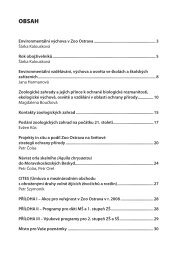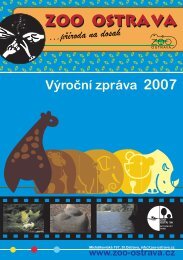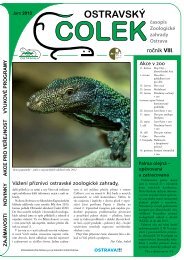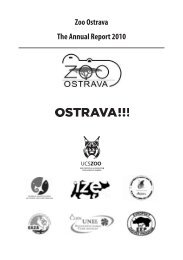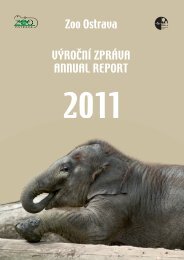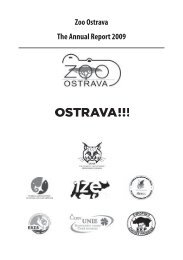výroÄnà zpráva 2009 ( 4,12 MB ) - Zoo Ostrava
výroÄnà zpráva 2009 ( 4,12 MB ) - Zoo Ostrava
výroÄnà zpráva 2009 ( 4,12 MB ) - Zoo Ostrava
- No tags were found...
Create successful ePaper yourself
Turn your PDF publications into a flip-book with our unique Google optimized e-Paper software.
44Breeding the rarest lemur at <strong>Ostrava</strong> <strong>Zoo</strong>Jana Kanichová<strong>Ostrava</strong> <strong>Zoo</strong> has been devoted to breeding the Sclater's lemur (Eulemur macaco flavifrons) since 2004,when an 8-year-old female Melanie and a three-year-old male Micha were acquired from Mulhouse andCologne, respectively. The animals could be obtained through AEECL membership (Association Européennepour l'Étude et la Conservation des Lémuriens, the lemur conservation association), which is determined byannual financial contribution for this organisation, where the money are subsequently forwarded durectly toMadagascar, Sahamalaza Peninsula, where research dedicated to this beautiful blue-eyed lemur is underway.A new nature reserve was established in Sahamalaza over time with support of the Madagascar government,giving the endangered lemurs the chance to survive. Burning vegetation, meaning total elimination of placeswhere the animals could dwell, presents the biggest conservation issue on the island. Only estimates exist fornumbers in the wild, with a maximum of 3,000 individuals reported. Unfortunately, chances of the species forsurvival shrink due to continued burning, which takes place even in reserves. Greatly reduced opportunitiesfor the Madagascar's nature as such based on the recent political instability of the country are also thereason why captive breeding is so important for the Sclater's lemur. Sadly, the situation in zoological parks iscatastrophic, giving only a little hope for sustaining a healthy and reproductive population in future.Europe started captive breeding in the Sclater's lemur in 1984, followed by the USA in 1985. A total of 20founder animals (9 males and 11 females) were imported from the wild, with eight founders (4,4) based inEurope, seven (2,5) in the USA and five (3,2) in Madagascar. However, not all animals reproduced and if theydid, the majority of their descendants failed to become involved in breeding. From 1984 until the end of<strong>2009</strong>, 195 animals (93,85,17) came and left captive breeding institutions, of which 111 were live-born and 64stillborn animals. There were five cases of twins, including three cases of the young reared successfully by theparents. Over the breeding history, live offspring was produced by 51 animals (27,24), of which 21 were basedin the USA (<strong>12</strong>,9), 20 in Europe (10,10) and 10 in Madagascar (5,5). Only dead young occurred in 13 individuals(5,8), from which four were held in the USA (1,3), nine in Europe (4,5) and none in Madagascar.Currently, the Sclater's lemur is kept in 25 institutions throughout the world, with the captive stockcomprising 71 animals. The European stock contains 29 Sclater's lemurs (15,14), with only three females thatdeliver live animals, of which, however, one female has not been able to care of the young so far. There isanother small hope with three females that have already bore, but stillborn animals were the only results.In addition, three of those six females that have already given birth are old. The oldest female of this lemurspecies that ever gave birth in the captive situation was 16 years old. The current USA stock counts 30 animals(21,9), with only a single female breeder and four females that are rather old and bore only stillborn animals.The situation in Madagascar zoos does not provide very good overview. Nonetheless, eleven animals (3,8) arereported.At <strong>Ostrava</strong> <strong>Zoo</strong>, the "blue-eyed" did very well early in <strong>2009</strong>. Following five years, when the breeding pairMelanie and Micha produced just a single stillborn infant in 2006, offspring was born to the female Melanieon 10 May <strong>2009</strong> and reared by the mother despite the initial nervousness. A few days after, the infant wasfound to be a male. As everybody was feeling really good seeing that Melanie and Micha made it, the youngone was named Ravu, which in the Malagasy language means "happy". A new island exhibit was constructed





